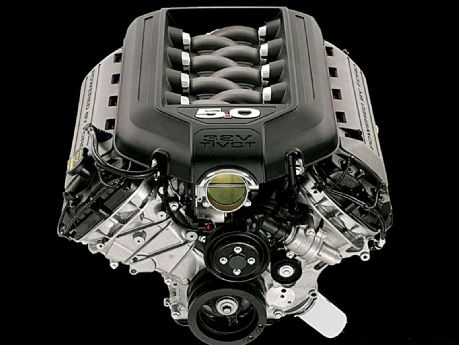The Ford engineers has a directive to come up with an engine that would compete with the GM and Chrysler engines, be about the same size as the 4.6L Modular engine, yield 400 HP and fit in the Mustang. And it had to be an engine that would give Ford what it needed for years to come. The Coyote was first introduced in the 2011 Mustang GT. A factory racing engine for the street and available in the Mustang.
This first place to start telling about this car is engine. The Coyote 5.0L is:
- An All Aluminum block and heads
- Double Overhead Cam
- 4 valves per cylinder
- Roller Rocker Arms
- 435 HP 400 lbs ft torque
- Port fuel injection
- VCT (Variable cam timing)

The Coyote 5.0 is the first engine that was designed specifically for the Mustang. It is the latest evolution of the 5.0 liter. But it is not a continuation of the Ford 302.5.0 V8 block. It comes from the 4.6 and 5.4 Modular series.. It is roughly the same dimensions as the earlier modular engines but this engine is something real special. It has a compression ratio of 11.0:1 but will run on 87 octane gas. It has port injection instead of direct injection into the cylinder heads. The firing order is not the same as the previous Modular V8’s. (1-3-7-2-6-5-4-8) instead it is same as the old Flathead V8 (1-5-4-8-6-3-7-2). The rod to stroke ratio is 1.62:1, the same as the earlier Modular 4.6L, with a 5.933″ connecting rod.

This engine has magic all around it. One place magic happens are the cylinder heads. The heads are all Aluminum, 4 valve per cylinder, double over head cam (DOHC) setup. The camshafts are outboard rather than between the cylinders. This allows for more compact, roller rocker hydraulic valve train. These heads outflow the Ford GT intake ports by 4% and the Yates D3-Nascar intake ports by 0.472 lift. Those are basically racing heads. And this is what you get with any V-8 Mustangs with this engine. Engine redline is 7000 RPM.

This is the first Ford engine that has cam-torque-actuated (CTA) Twin Independent Variable Cam Timing. (Ti-VCT). This allows the control module (PCM) to advance and retard cam timing on the intake and exhaust independently of each other. This yields more power, better fuel economy and less emissions. All the Coyote engines are built in Ford’s Essex Engine Plant in Windsor, Ontario, Canada.
How fast is a 2017 Mustang GT with this engine?
- 0-60 4.5 secs
- 0-75 6.8 secs
- 1/4 Mile 13.0 secs @111.4 MPH
- 60-0 105 feet
Generation 1 Coyote – 412 HP, 390 Lbs Ft Torque
The 2012 Boss 302 was a very special use of the Coyote engine. This version was tweaked producing 444 HP and 380 lbs./ft. torque.
Generation 2 Coyote – found in the 2015 Mustang, was rated at 435 HP, 400 lbs.ft torque. New intake, better heads learned from the Boss 302 version.
Generation 3 Coyote – Duel fuel, high pressure direct and low pressure injections, improved heads, Larger valves, new intake, upgraded bearings, and a viscous crank damper rated at 460 HP and 420 lbs.ft. torque.
Some Links to pages with more information about this modular engine.
- Everything You Ever Wanted to Know About the Coyote Powerplant: Return of the 5.0 at Mustang360 at MustangsandFords.com
- FORD COYOTE ENGINES: HOW TO BUILD MAX PERFORMANCE – Jim Smart’s excellent book on the Ford Coyote 5.0